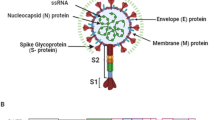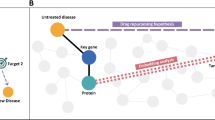Abstract
Domain–motif interactions (DMIs) represent transient bonds formed when a Short Linear Motif (SLiM) engages a globular domain via a compact contact interface. Understanding the mechanics of DMIs is critical for maintaining diverse regulatory processes and deciphering how various viruses hijack host cellular machinery. However, identifying DMIs through traditional in vitro and in vivo experiments is challenging due to their degenerate nature and small contact areas. Predictions often carry a high rate of false positives, necessitating rigorous in-silico validation before embarking on experimental work. This study assessed the binding energy changes in predicted SLiM instances through in-silico peptide exchange experiment, elucidating how they interact with known 3D DMI complexes. We identified a subset of potential mimicry candidates that exhibited effective binding affinities with native DMI structures, suggesting their potential to be true mimicry candidates. The identified viral SLiMs can be potential targets in developing therapeutics, opening new opportunities for innovative treatments that can be finely tuned to address the complex molecular underpinnings of various diseases. To gain a comprehensive understanding of identified DMIs, it is imperative to conduct further validation through experimental approaches.

Similar content being viewed by others
Data availability
This article contains excerpts from Idrees' thesis published in 2020 (Idrees 2020).
References
Aloy P, Russell RB (2006) Structural systems biology: modelling protein interactions. Nat Rev Mol Cell Biol 7(3):188–197
Arabidopsis Interactome Mapping C (2011) Evidence for network evolution in an Arabidopsis interactome map. Science 333(6042):601–607
Benedict CA, Norris PS, Ware CF (2002) To kill or be killed: viral evasion of apoptosis. Nat Immunol 3(11):1013–1018
Bjorkholm P, Sonnhammer EL (2009) Comparative analysis and unification of domain-domain interaction networks. Bioinformatics 25(22):3020–3025
Butland G et al (2005) Interaction network containing conserved and essential protein complexes in Escherichia coli. Nature 433(7025):531–537
Davey NE et al (2017) Discovery of short linear motif-mediated interactions through phage display of intrinsically disordered regions of the human proteome. FEBS J 284(3):485–498
Dinkel H et al (2012) ELM–the database of eukaryotic linear motifs. Nucleic Acids Res 40(Database issue):D242–D251
Dinkel H et al (2016) ELM 2016-data update and new functionality of the eukaryotic linear motif resource. Nucleic Acids Res 44(D1):D294-300
Durmus Tekir S et al (2013) PHISTO: pathogen-host interaction search tool. Bioinformatics 29(10):1357–1358
Edwards RJ (2013) SLiMSuite software package. 2013. http://www.southampton.ac.uk/~re1u06/software/packages/slimsuite/. Accessed 05 Feb 2019
Edwards RJ, Palopoli N (2015) Computational prediction of short linear motifs from protein sequences. Methods Mol Biol 1268:89–141
Evans P et al (2009) Prediction of HIV-1 virus-host protein interactions using virus and host sequence motifs. Bmc Med Gen 2:27. https://doi.org/10.1186/1755-8794-2-27
Finlay BB, McFadden G (2006) Anti-immunology: evasion of the host immune system by bacterial and viral pathogens. Cell 124(4):767–782
Freund C et al (2002) Dynamic interaction of CD2 with the GYF and the SH3 domain of compartmentalized effector molecules. EMBO J 21(22):5985–5995
Gibson TJ et al (2015) Experimental detection of short regulatory motifs in eukaryotic proteins: tips for good practice as well as for bad. Cell Commun Signal 13:42
Glavina J et al (2018) Interplay between sequence, structure and linear motifs in the adenovirus E1A hub protein. Virology 525:117–131
Guirimand T, Delmotte S, Navratil V (2015) VirHostNet 20: surfing on the web of virus/host molecular interactions data. Nucleic Acids Res 43(Database issue):D583–D587
Hagai T et al (2011) Intrinsic disorder in ubiquitination substrates. J Mol Biol 412(3):319–324
Idrees S, Perez-Bercoff A, Edwards RJ (2018) SLiMEnrich: computational assessment of protein-protein interaction data as a source of domain-motif interactions. PeerJ 6:e5858
Idrees S (2020) Predicting motif mimicry in viruses. PhD, University of New South Wales, Sydney, Australia
Idrees S et al (2023) How different viruses perturb host cellular machinery via short linear motifs. EXCLI 22:1113–1128
Kiel C, Serrano L (2014) Structure-energy-based predictions and network modelling of RASopathy and cancer missense mutations. Mol Syst Biol 10:727
Kinoshita K, Nakamura H (2005) Identification of the ligand binding sites on the molecular surface of proteins. Protein Sci 14(3):711–718
Kumar M et al (2022) The Eukaryotic Linear Motif resource: 2022 release. Nucleic Acids Res 50(D1):D497–D508
Lee T et al (2004) Docking motif interactions in MAP kinases revealed by hydrogen exchange mass spectrometry. Mol Cell 14(1):43–55
Linding R et al (2007) Systematic discovery of in vivo phosphorylation networks. Cell 129(7):1415–1426
Luck K et al (2020) A reference map of the human binary protein interactome. Nature 580(7803):402–408
Meszaros B et al (2017) Degrons in cancer. Sci Signal 10(470):1–29
Mihalic F et al (2023) Large-scale phage-based screening reveals extensive pan-viral mimicry of host short linear motifs. Nat Commun 14(1):2409
Miller ML et al (2008) Linear motif atlas for phosphorylation-dependent signaling. Sci Signal 1(35):ra2
Mosca R et al (2014) 3did: a catalog of domain-based interactions of known three-dimensional structure. Nucleic Acids Res 42(Database issue):D374–D379
Pawson T, Linding R (2005) Synthetic modular systems–reverse engineering of signal transduction. FEBS Lett 579(8):1808–1814
Rajagopala SV et al (2014) The binary protein-protein interaction landscape of Escherichia coli. Nat Biotechnol 32(3):285–290
Rose PW et al (2017) The RCSB protein data bank: integrative view of protein, gene and 3D structural information. Nucleic Acids Res 45(D1):D271–D281
Rual JF et al (2005) Towards a proteome-scale map of the human protein-protein interaction network. Nature 437(7062):1173–1178
Schymkowitz J et al (2005) The FoldX web server: an online force field. Nucleic Acids Res 33(Web Server issue):W382–W388
Segura-Cabrera A et al (2013) A viral-human interactome based on structural motif-domain interactions captures the human infectome. PLoS One 8(8):1–13
Stark C et al (2006) BioGRID: a general repository for interaction datasets. Nucleic Acids Res 34(Database issue):D535–D539
Stein A, Aloy P (2008) Contextual specificity in peptide-mediated protein interactions. PLoS ONE 3(7):e2524
Van Roey K, Gibson TJ, Davey NE (2012) Motif switches: decision-making in cell regulation. Curr Opin Struct Biol 22(3):378–385
Venkatakrishnan AJ et al (2020) Benchmarking evolutionary tinkering underlying human-viral molecular mimicry shows multiple host pulmonary-arterial peptides mimicked by SARS-CoV-2. Cell Death Discov 6(1):96
Yu H et al (2008) High-quality binary protein interaction map of the yeast interactome network. Science 322(5898):104–110
Zarrinpar A, Park SH, Lim WA (2003) Optimization of specificity in a cellular protein interaction network by negative selection. Nature 426(6967):676–680
Acknowledgements
The authors would like to acknowledge the University of New South Wales, Sydney, and Dr. Richard J. Edwards.
Funding
This work was supported by the University of New South Wales through a University International Postgraduate Award to Sobia Idrees. The authors received no funding support for publication of this article.
Author information
Authors and Affiliations
Contributions
SI performed the experiments, analysed the data, contributed analysis tools, prepared figures and/or tables, authored or reviewed drafts of the paper, and approved the final draft. KRP authored or reviewed drafts of the paper and approved the final draft.
Corresponding author
Ethics declarations
Conflict of interest
The authors declare no conflict of interest.
Additional information
Communicated by Yusuf Akhter.
Publisher's Note
Springer Nature remains neutral with regard to jurisdictional claims in published maps and institutional affiliations.
Supplementary Information
Below is the link to the electronic supplementary material.
Rights and permissions
Springer Nature or its licensor (e.g. a society or other partner) holds exclusive rights to this article under a publishing agreement with the author(s) or other rightsholder(s); author self-archiving of the accepted manuscript version of this article is solely governed by the terms of such publishing agreement and applicable law.
About this article
Cite this article
Idrees, S., Paudel, K.R. Bioinformatics prediction and screening of viral mimicry candidates through integrating known and predicted DMI data. Arch Microbiol 206, 30 (2024). https://doi.org/10.1007/s00203-023-03764-w
Received:
Revised:
Accepted:
Published:
DOI: https://doi.org/10.1007/s00203-023-03764-w




